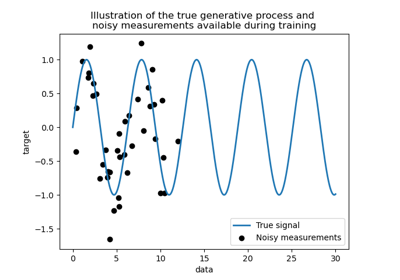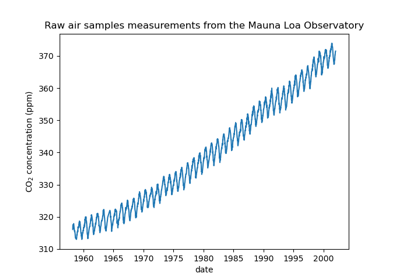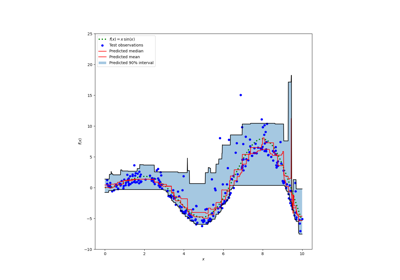注意
转到末尾 下载完整的示例代码,或通过 JupyterLite 或 Binder 在浏览器中运行此示例。
高斯过程回归:基本入门示例#
以两种不同方式计算的简单一维回归示例
无噪声情况
有噪声情况,已知每个数据点的噪声水平
在这两种情况下,核的参数都使用最大似然原理进行估计。
这些图表说明了高斯过程模型的插值特性以及其概率性质(以点式 95% 置信区间形式表示)。
请注意,alpha 是一个参数,用于控制 Tikhonov 正则化对假定的训练点协方差矩阵的强度。
# Authors: The scikit-learn developers
# SPDX-License-Identifier: BSD-3-Clause
数据集生成#
我们将从生成一个合成数据集开始。真实的生成过程定义为 \(f(x) = x \sin(x)\)。
import numpy as np
X = np.linspace(start=0, stop=10, num=1_000).reshape(-1, 1)
y = np.squeeze(X * np.sin(X))
import matplotlib.pyplot as plt
plt.plot(X, y, label=r"$f(x) = x \sin(x)$", linestyle="dotted")
plt.legend()
plt.xlabel("$x$")
plt.ylabel("$f(x)$")
_ = plt.title("True generative process")
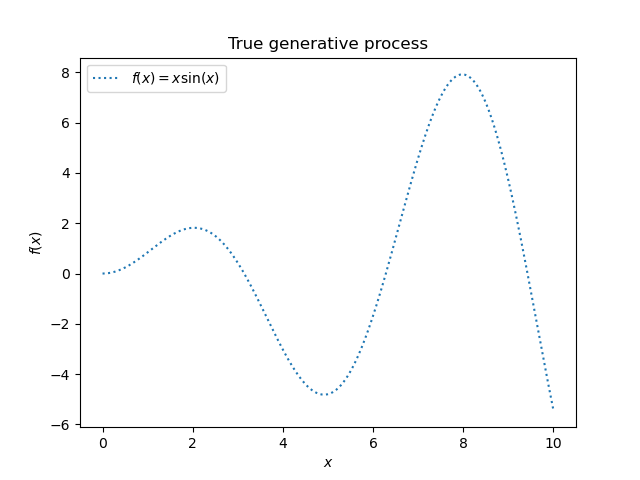
我们将在接下来的实验中使用这个数据集来说明高斯过程回归是如何工作的。
无噪声目标的示例#
在第一个示例中,我们将使用真实的生成过程而不添加任何噪声。为了训练高斯过程回归,我们将只选择少量样本。
rng = np.random.RandomState(1)
training_indices = rng.choice(np.arange(y.size), size=6, replace=False)
X_train, y_train = X[training_indices], y[training_indices]
现在,我们对这些少量训练数据样本拟合一个高斯过程。我们将使用径向基函数(RBF)核和一个常数参数来拟合振幅。
from sklearn.gaussian_process import GaussianProcessRegressor
from sklearn.gaussian_process.kernels import RBF
kernel = 1 * RBF(length_scale=1.0, length_scale_bounds=(1e-2, 1e2))
gaussian_process = GaussianProcessRegressor(kernel=kernel, n_restarts_optimizer=9)
gaussian_process.fit(X_train, y_train)
gaussian_process.kernel_
5.02**2 * RBF(length_scale=1.43)
拟合模型后,我们看到核的超参数已被优化。现在,我们将使用我们的核来计算整个数据集的平均预测并绘制 95% 置信区间。
mean_prediction, std_prediction = gaussian_process.predict(X, return_std=True)
plt.plot(X, y, label=r"$f(x) = x \sin(x)$", linestyle="dotted")
plt.scatter(X_train, y_train, label="Observations")
plt.plot(X, mean_prediction, label="Mean prediction")
plt.fill_between(
X.ravel(),
mean_prediction - 1.96 * std_prediction,
mean_prediction + 1.96 * std_prediction,
alpha=0.5,
label=r"95% confidence interval",
)
plt.legend()
plt.xlabel("$x$")
plt.ylabel("$f(x)$")
_ = plt.title("Gaussian process regression on noise-free dataset")
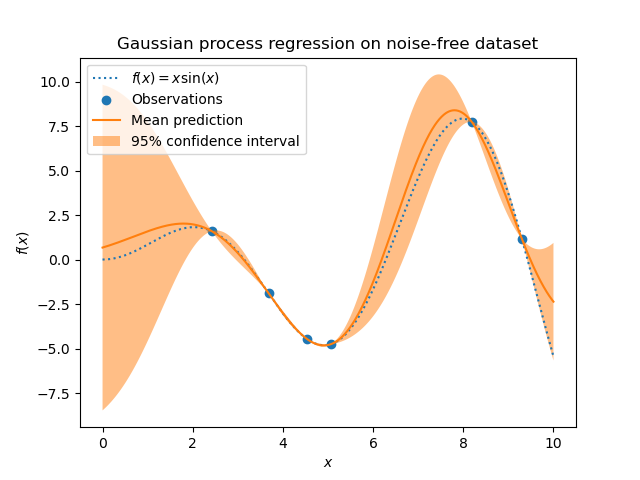
我们看到,对于在接近训练集的点上进行的预测,95% 置信区间较小。当样本远离训练数据时,模型的预测准确性较低,且模型的预测精度较低(不确定性更高)。
有噪声目标的示例#
我们可以重复一个类似的实验,这次向目标添加额外的噪声。这将允许我们看到噪声对拟合模型的影响。
我们向目标添加一些具有任意标准差的随机高斯噪声。
noise_std = 0.75
y_train_noisy = y_train + rng.normal(loc=0.0, scale=noise_std, size=y_train.shape)
我们创建一个类似的高斯过程模型。除了核之外,这次我们指定了参数 alpha,它可以被解释为高斯噪声的方差。
gaussian_process = GaussianProcessRegressor(
kernel=kernel, alpha=noise_std**2, n_restarts_optimizer=9
)
gaussian_process.fit(X_train, y_train_noisy)
mean_prediction, std_prediction = gaussian_process.predict(X, return_std=True)
让我们像以前一样绘制平均预测和不确定性区域。
plt.plot(X, y, label=r"$f(x) = x \sin(x)$", linestyle="dotted")
plt.errorbar(
X_train,
y_train_noisy,
noise_std,
linestyle="None",
color="tab:blue",
marker=".",
markersize=10,
label="Observations",
)
plt.plot(X, mean_prediction, label="Mean prediction")
plt.fill_between(
X.ravel(),
mean_prediction - 1.96 * std_prediction,
mean_prediction + 1.96 * std_prediction,
color="tab:orange",
alpha=0.5,
label=r"95% confidence interval",
)
plt.legend()
plt.xlabel("$x$")
plt.ylabel("$f(x)$")
_ = plt.title("Gaussian process regression on a noisy dataset")
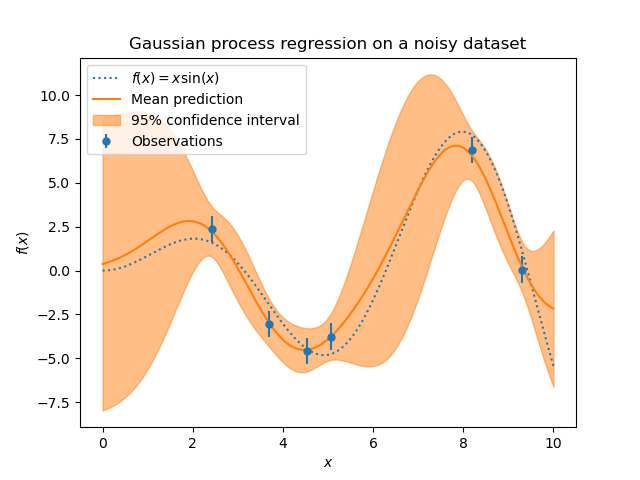
噪声影响了靠近训练样本的预测:靠近训练样本的预测不确定性更大,因为我们明确地对给定水平的目标噪声进行了建模,该噪声独立于输入变量。
脚本总运行时间: (0 minutes 0.425 seconds)
相关示例
